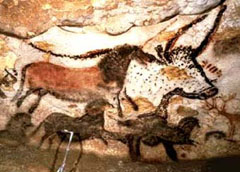HOME | SYNOPSIS | TREATMENT | IMAGES + CLIPS | PEOPLE
TreatmentCopyright in the Digital Age
|
Opening Montage: |

|
||||||
Pirates consists of four movements, or acts, which trace the narrator's struggle to make peace with piracy -- to either live within the law, or have sound basis for civil disobedience. In the course of this quest, we hear from experts, artists, authors and activists and learn how copyright issues play out in their lives and work.
Act 1:Confessions of A Pirate |
|
||||||
Act 1: Confessions of Pirate
The film opens as a documentary on recent changes in copyright law asking whether there's a looming threat to any of your everyday practices. It gives an overview of the high profile battles over copyright (the DMCA, Napster, Internet radio, arrest of Dmitry Sklyarov). Then it brings these abstract issues home in a sequence entitled, "Are you a pirate?" Here we meet different people (identities obscured) as they confess to common acts of piracy (copying software, making mix CDs of music, taping sports broadcasts, photocopying books). This sequence builds with more and more images of cassettes, labels, and hands making copies, all ordinary sights, shot surveillance-style to convey illegality.
Next we meet the main subjects and ask, not in jest, but with a winking tone, if they've ever committed an act of piracy. In the course of these conversations, we learn the basics of the American tradition of copyright. We hear about the struggle to reconcile everyday practice with ethics and ideals. Those who know the law explain key points, others tell of their dilemmas and confusion, and the narrator interjects with illustrative sidebars. "What would happen if the technology for playing movies, games, music, software and other media were such that the laws could be perfectly enforced?" By the end of the opening act, we see that perfect enforcement is indeed the aim of many new laws and technologies; and we have a keen sense that this might bring radical, painful changes, not just to pirates "out there", but to everyday life as we know it.
Act 2: Copyright/Copyleft: How Openness Creates Value
In this movement, we learn how openness can create value: what is seen by some as a threat to creativity, is seen here as the source of great treasure. We learn about copyleft (an alternative to copyright that protects openness) and open source software from law professor, Larry Lessig, and hackers, Rob Malda and Jeff Bates. A visual representation of the copyleft model will show the geometric progression of how a piece of software can fan out to a wide group and change over time. A series of people and their contributions can be seen in CVS logs. The idea is to illustrate that open source is a social, not a technical, revolution. A code walk through will visually depict the social aspects of code, scrolling through comments with the programmer giving a blow by blow description of the changes made to the original. The idea is to show what code looks like, and emphasize that it embodies both a conversation with the machine and a conversation with those who might edit the program in the future.
Act 3: Fruits of Our Labor
While the previous movement explores the social dimensions of knowledge property, this movement is a meditation on the idea that artists should be rewarded for their creative endeavors. Here we seek to anticipate and answer objections raised in the previous acts.
Writers, Marjorie Ingall and John Brancato, and performance artist, Ledoh, talk of how they protect their creations and explore the thorny issues of fair use , inspiration, parody, and homage. In one sense this is the counterpoint to the previous movement, but it shows unequivocally that the rewards of creation go far beyond monetary gain.
Act 4: Preserving the Cultural Commons: a Balancing Act
The film's last movement is one of synthesis emphasizing the commonalties in diverse viewpoints, and highlighting the balance between individuals and the public domain enshrined in the tradition of U.S. copyright law.
Theme:
The overarching theme of the documentary is that we all stand on the shoulders of giants, that knowledge and works of art are something more -- and different -- than ordinary property. The wider theme is that a free society must strike a balance between private and public goods
Style:
Though intellectual property may seem like a dry topic, this film will subvert that assumption with movement and strong visuals, drawn from the inherently visual work of some of the film's subjects.
Digitally processed abstract footage and short CGI sequences will also be used to create the dream landscape of the narrator's stories. Screen space will be used not only for full frame video, but also as an imitation of both a television and desktop screen, with different windows, scrolling graphics and textual images overlaid on the video. The overall effect is to be one of hypermedia with insets, sidebars, and a constant stream of bits and digits. The visual style should convey the sense of information flow, the Internet as a vast threaded public conversation, the bit stream coursing through the veins of 21st century social bodies. In keeping with the desktop theme, the narrator controls a mouse/pointer, and chooses, clicks and navigates around the screen in certain scenes.
My interviewing technique and method of collaboration will also shape the documentary's style. I look upon my subjects as collaborators, as experts witnesses whose testimony supports, enlarges and comments on my own message as a filmmaker, rather than as fragments of reality to be "captured". Thus, I always show and discuss the work-in-progress, asking subjects to explore issues, and showing them footage of other people's interviews. The idea is to create a civic conversation, a virtual town hall meeting.
HOME | SYNOPSIS | TREATMENT| IMAGES + CLIPS | PEOPLE

